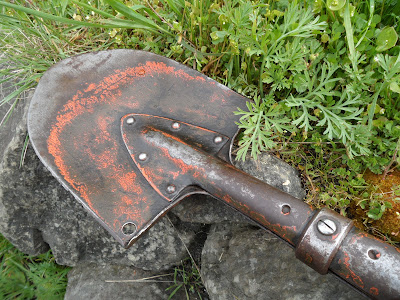I have a real soft spot for all things Finnish when it comes to field equipment. They are usually steeped in many layers of history, and have that "old world" feel and patina, and well, they are also just plain cool! This new shovel fits those points exactly.
I ran across a company in Finland that had a small batch of these old shovels for sale. They said they were all rough, but usable (that pretty much describes all Finnish gear). The price and shipping costs were great, so I went ahead and bought one. The company was right, my shovel was "rough", but had some amazing features.
When I received this shovel, most of the painted area was still covered in old "tar paint" preservative. From around the edges of the tar, I could see some layers of orange and green paint. I did a little bit of scrubbing with a 3M pad and some acetone to remove most of the black tar paint, to reveal the layers of orange and green paint underneath.
It appears that this shovel was originally bare metal, then painted with orange paint, then painted over with green paint, then painted over with black tar paint, and ultimately issued back out and used in that condition. Most of the black tar paint had worn away and only covered the actual painted section you can see on the shovel, so I am guessing that it was pulled form storage and was used again in a more modern time frame.
From what I understand, the orange paint is usually found on shovels that were issued to the Civil Defense units for use in disasters. The green paint is reserved for military use.
With the multiple layers of paint on this shovel, any hope of seeing stamped makers markings and dates, has been dashed, unless I want to strip all of the old paint off. Since I like to keep all of the "history" intact, I'll be choosing to leave those layers intact.
There is one making on the blade that is visible though. It is the number "2041" on the right wing of the blade.
There is an identification disc nailed in place on the end of the wood handle shaft, inside the D-handle. This disc is marked "41". I am guessing that the "41 disc" goes along with the "2041" stamp on the blade. It must be some kind of identification or inventory number.
The handle shaft on this shovel appears to have been replaced at some point along the way, most likely back in the 1930's or 1940's. You can see the old, and unused, original rivet holes. A ring was installed and then tapped up tight after the new handle was installed. The ring is fastened with a screw.
It is my guess that this shovel was most likely an Imperial Russian shovel that was "rebuilt" in the Finnish Armory to be reissued out to the army for the Winter War and Continuation War. I will never be able to know for sure unless I remove all of the blade paint though.
The wood handle shaft has some wonderful initials carved into it. I love these personal touches and will always choose an artifact with "character" over a "mint condition" one any day of the week!
I have another Finnish rebuilt shovel that was converted from an old Imperial Russian shovel. You can read about that shovel on my older blog posting, as well learn more about the history of these Finish Engineer - Sapper shovels. Here is the link:
https://sharky-fourbees.blogspot.com/2017/03/finish-army-engineer-sapper-shovel.html
My shovel has the classic Finnish Army blade hole as well, for carrying on a belt hook. Now I need to track down an old belt hook!
Now let's take a close look at this beautiful piece of Finnish history.




























No comments:
Post a Comment